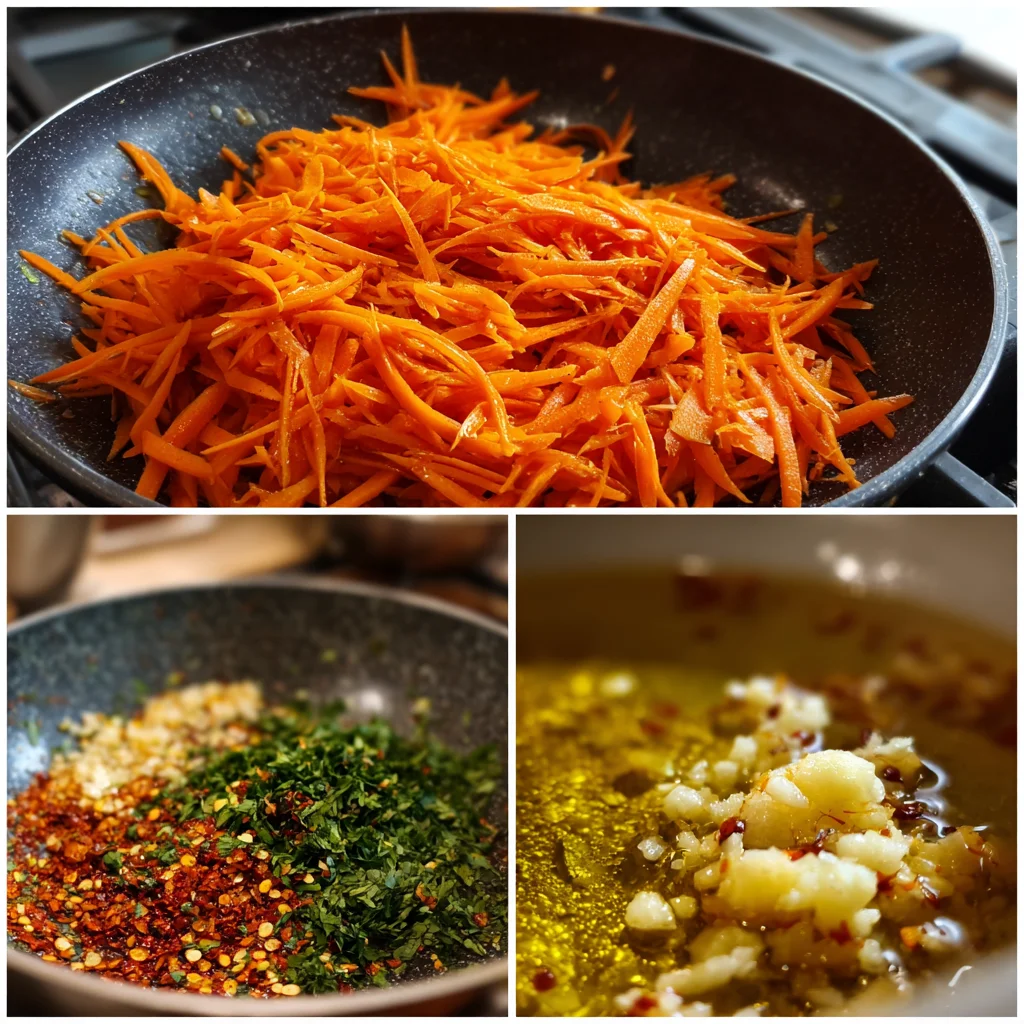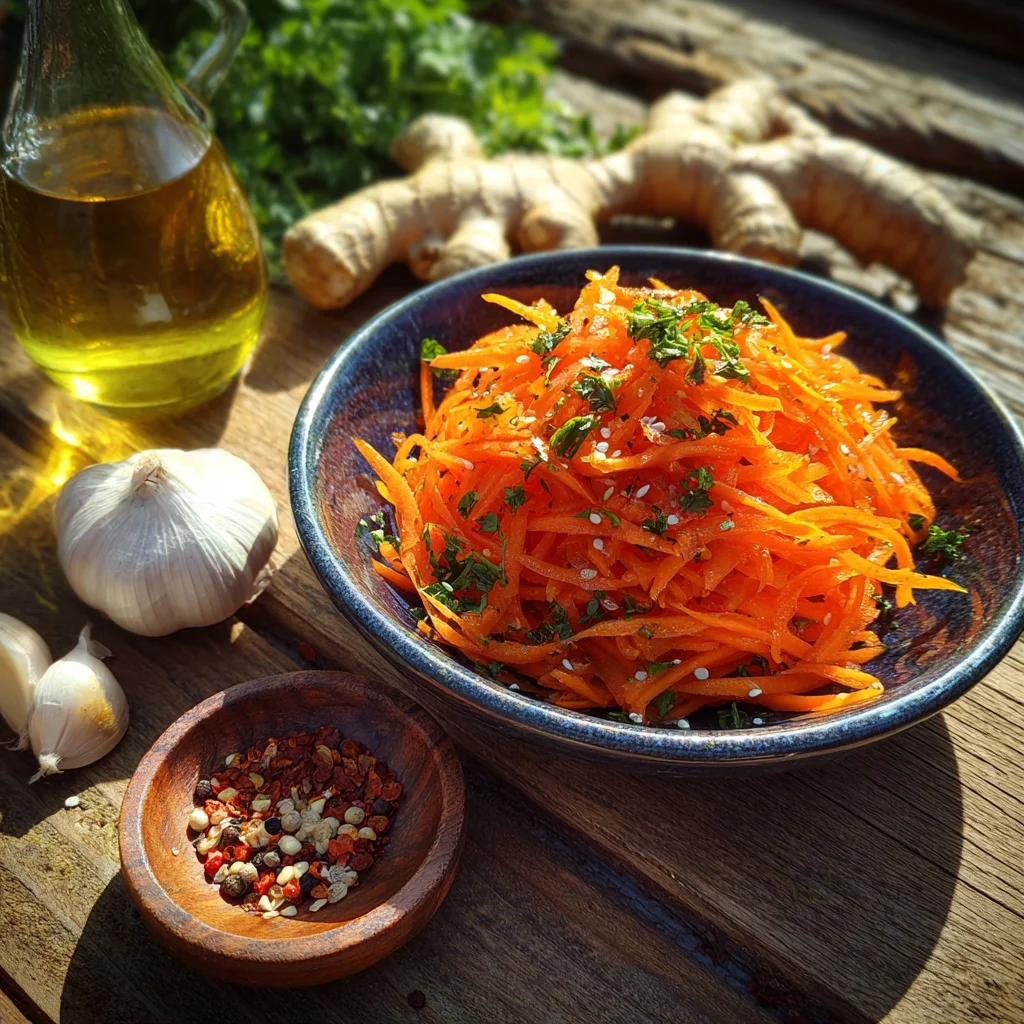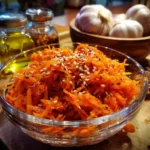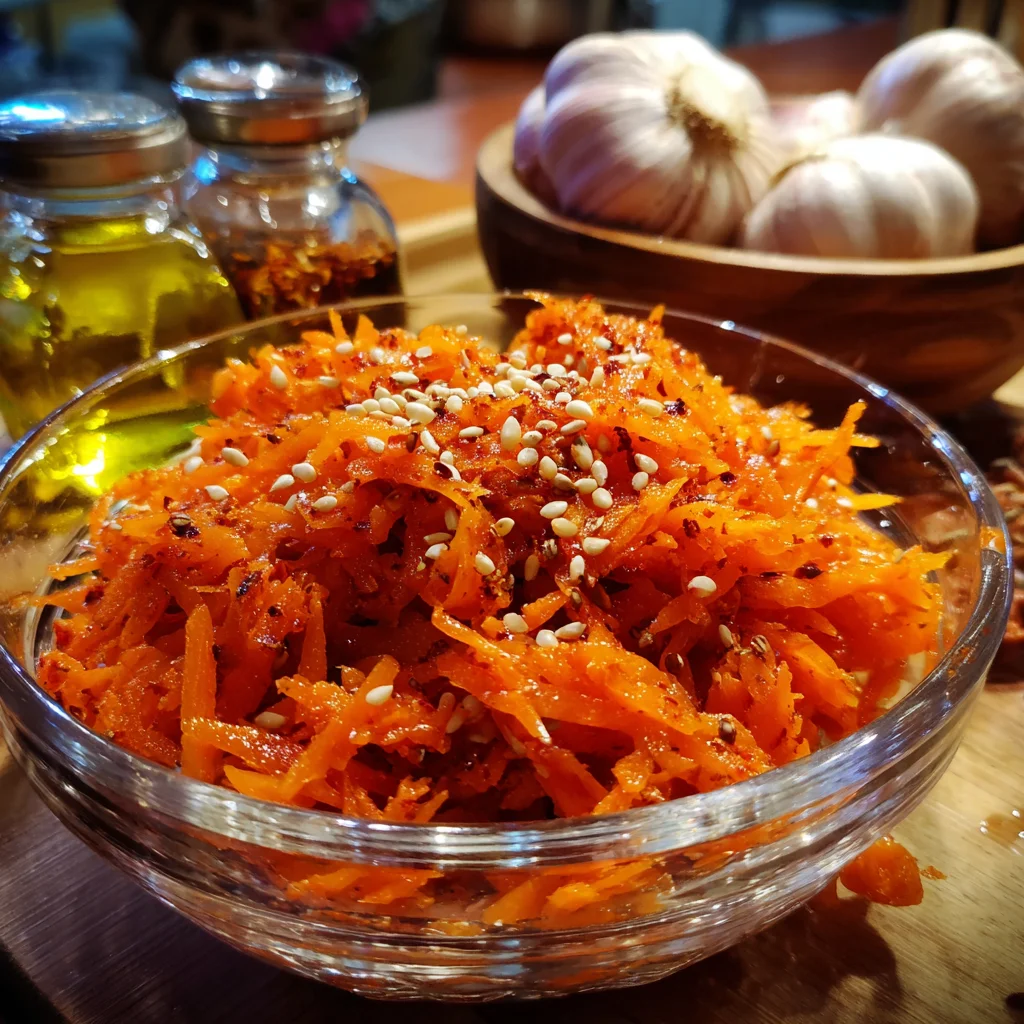Craving something crunchy, spicy, and wildly addictive—but still healthy? Meet the Korean Carrot Salad. Despite its name, this bold and vibrant side dish doesn’t come from Korea—but it’s packed with the kind of flavor that keeps you coming back.
Popularized in Eastern Europe by ethnic Koreans, this tangy, garlicky salad is now winning hearts in wellness circles for its hormone-friendly ingredients and clean-eating profile. You’ll learn exactly how to make it, what oils and spices bring it to life, and why it might just be the most shockingly good carrot salad you’ve ever had.
Don’t miss our exclusive Detox & Metabolism Boosters—a perfect companion for this fiery, functional dish.
Table of Contents
Table of Contents
What Is Korean Carrot Salad?
The Surprising Roots of Korean Carrot Salad
Despite its name, Korean carrot salad isn’t actually a traditional Korean dish. It was developed by ethnic Koreans who were relocated to former Soviet countries such as Uzbekistan and Kazakhstan. These ethnic Koreans, known as Koryo-saram, blended their culinary traditions with local ingredients to craft something entirely new.
Without access to traditional ingredients like Napa cabbage—commonly used in Korean dishes—they got creative. They turned to fresh carrots, slicing them into thin strips and seasoning them with garlic, vinegar, chili, and coriander to mimic the tang and spice found in dishes like kimchi.
The result? A crunchy, zesty salad with an unmistakable Korean-inspired kick, despite being developed far from the Korean peninsula.
So, Is It Really Korean?
Technically, no—but it borrows the spirit of Korean flavor. In fact, most people in Korea have likely never heard of this dish. You won’t find it at traditional Korean BBQ joints or Seoul street vendors.
However, in countries like Russia, Ukraine, and Uzbekistan, it’s a staple side dish known as “Koreyskaya Morkovka”, which literally means “Korean-style carrots.” It’s popular at home, in delis, and at celebrations, loved for its bright color, bold taste, and shelf life.
So while it might not come from Korea, this dish channels the essence of Korean seasoning in a completely fresh, cross-cultural way—making it a flavorful standout on any table.
Ingredients Used in Korean Carrot Salad
Essential Core Ingredients You Can’t Skip
Here’s what you need to create an authentic Korean carrot salad base:
| Ingredient | Purpose |
|---|---|
| Carrots (julienned) | Crunchy texture, natural sweetness |
| Garlic (minced) | Punch of flavor, antibacterial |
| Vinegar (white or apple cider) | Brightness, shelf-life boost |
| Coriander seed (ground) | Earthy depth |
| Chili flakes or powder | Heat and color |
| Salt | Balance and preservation |
These core ingredients provide the signature taste profile of the salad: sharp, spicy, tangy, and refreshing.
Optional Add-Ins to Elevate Flavor and Texture
Looking to add more complexity or a personal twist to your Korean carrot salad? These optional ingredients help enhance both taste and texture—making each bite even more exciting.
Here are some of the best extras to consider:
- Toasted sesame seeds or oil – Brings a warm, nutty aroma that complements the chili and garlic
- Thinly sliced bell peppers – Add a splash of color, mild sweetness, and extra crunch
- Natural sweeteners – A small amount of honey, coconut sugar, or maple syrup helps round out the acidity if the vinegar is too punchy
- Coconut aminos or tamari – Delivers a gentle umami boost without overpowering the natural carrot flavor
- Fresh herbs like cilantro or flat-leaf parsley – Add brightness and contrast to the spiced base
- Minced ginger – Offers subtle heat and zing, perfect for a deeper flavor profile
- Paper-thin red onions (optional) – Provide a little sharpness and a satisfying bite
This recipe is highly customizable. Whether you follow a vegan, keto, or low-sodium diet, you can tweak ingredients to suit your lifestyle while still keeping the vibrant essence of the dish intact.
By mixing and matching these elements, you can make your salad as bold or balanced as you like—all without sacrificing its iconic crunch and spice.
How to Make Korean Carrot Salad at Home
Step-by-Step Traditional Recipe
Ready to bring this spicy, crunchy salad into your kitchen? Here’s how to prepare an authentic Korean carrot salad with minimal fuss and maximum flavor.
Ingredients:
- 4 large carrots, peeled and cut into thin strips
- 3 garlic cloves, minced
- 1 tsp ground coriander
- 1 tsp chili flakes or gochugaru (Korean chili powder)
- 2 tbsp apple cider or white vinegar
- 4 tbsp sunflower or another neutral oil
- Salt, to taste

Instructions:
- Slice the carrots into very thin matchsticks using a mandoline or sharp knife. Uniform size helps the marinade soak evenly.
- Lightly salt the carrots and mix well. Let them rest for around 10 minutes—this draws out excess liquid and makes them more pliable without going limp.
- Drain any liquid, then toss in the garlic, coriander, and chili flakes to coat the carrots evenly.
- Heat your oil in a small pan until it’s hot—bubbles may appear on a wooden spoon, or it will ripple in the pan. Be careful not to let it smoke.
- Pour the hot oil directly onto the carrot mixture, targeting the garlic and spices. This method releases bold aromas and adds a deep, savory flavor to the dish.
- Stir in the vinegar and combine until everything is well coated.
- Refrigerate the salad, covered, for several hours—four at a minimum. Letting it sit overnight delivers the most balanced, bold flavor.
- Give it one last mix before serving, and taste it. You can fine-tune it with a pinch more salt, spice, or vinegar if desired.
This process creates a beautifully seasoned, crunchy, and flavorful salad that only gets better with time.
Best Oil to Use for Korean Carrot Salad
Sunflower Oil vs. Sesame Oil: Which Is Better?
One of the most defining elements of Korean carrot salad is the oil. Not just for moisture—it’s all about flavor infusion. Pouring hot oil over the raw spices and garlic is what activates the deep, savory aroma that makes this salad so addictive.
Here are your top two options:
| Oil Type | Flavor Profile | Smoke Point | Best Use |
|---|---|---|---|
| Sunflower Oil | Clean, neutral, lets spices shine | High (440°F) | Classic, traditional |
| Toasted Sesame Oil | Nutty, intense aroma | Low (350°F) | Fusion-style, flavor-rich |
Sunflower oil is the go-to in traditional recipes, especially in Russian and Central Asian households. It doesn’t compete with the garlic or coriander, making it ideal for the classic version.
Toasted sesame oil adds a rich nuttiness and is great if you’re leaning toward an Asian-fusion flavor. However, it burns easily—so it’s not ideal for the hot oil pour step unless mixed with a high-heat oil.
Pro Tip: For best results, heat sunflower oil, pour it over the salad, and then add a teaspoon of sesame oil afterward for flavor without burning.
How the Oil Impacts Flavor and Texture
Using the right oil doesn’t just add moisture—it activates:
- The pungency of garlic
- The warmth of coriander
- The brightness of chili flakes
If you use an oil that’s too strong (like olive oil), it can overpower those delicate spice notes. On the flip side, if you skip the hot oil step altogether, the salad will taste flat and raw instead of rich and layered.
Your oil is not just a base—it’s the flavor conductor. Get it right, and the whole dish sings.
Health Benefits of Korean Carrot Salad
Hormonal Balance: How Carrots Help Your Hormones
If you’re eating for hormonal health, Korean carrot salad might just be your secret weapon. Here’s why:
1. Carrots bind excess estrogen:
Raw carrots are rich in unique fibers that can bind to excess estrogen in the digestive tract, helping the body eliminate it naturally. This makes it especially beneficial for people dealing with estrogen dominance—a common root of PMS, bloating, acne, and weight gain.
2. Anti-inflammatory garlic:
Fresh garlic is not only flavorful—it’s packed with sulfur compounds that support liver detox pathways, which play a vital role in balancing hormones.
3. Natural detox booster:
The vinegar, carrots, and spices work synergistically to stimulate digestion, support bile production, and flush out toxins, making it a natural choice for metabolic support.
Looking for more natural ways to support hormone balance? Don’t miss our 3-Day Watermelon Detox Miracle.

Nutritional Breakdown of the Salad
This salad is deceptively simple, but it packs in some serious nutrition:
| Nutrient | Role in Body | Source |
|---|---|---|
| Beta-carotene | Eye health, skin glow, hormone support | Carrots |
| Vitamin K1 | Bone health, blood clotting | Carrots |
| Allicin | Anti-inflammatory, antimicrobial | Garlic |
| Antioxidants | Combat oxidative stress | Carrots, coriander |
| Healthy fats | Help absorb fat-soluble vitamins | Sunflower/sesame oil |
And the best part? This salad is naturally:
- Gluten-free
- Dairy-free
- Vegan
- Refined sugar-free
- Hormone-friendly
It fits clean eating and wellness lifestyles without sacrificing bold, satisfying flavor.
Serving Suggestions & Pairings
Best Dishes to Serve Korean Carrot Salad With
Korean carrot salad is more than just a side—it’s a flavor enhancer that pairs beautifully with all kinds of meals. Here are some great ideas for serving:
1. Grilled Meats & Kebabs
The salad’s sharp vinegar and spice cut through the richness of meats like chicken thighs, lamb skewers, or steak bites. It’s a killer companion to grilled kebabs or BBQ.
2. Rice or Grain Bowls
Add a scoop to a bowl of brown rice, quinoa, or farro with avocado, greens, and your favorite protein. It brings texture, tang, and a hit of spice to balance the dish.
3. Sandwiches or Wraps
Layer it in a wrap with tofu, falafel, or grilled chicken. The crunch adds texture while the garlic and chili elevate the whole experience.
4. Breakfast Eggs
Yes—eggs. Try this salad next to scrambled or poached eggs on toast. It adds zip and depth in the same way kimchi does.
5. Holiday Platters or Mezze Boards
Serving guests? This salad looks gorgeous and adds vibrant color to party platters or veggie boards.
Discover great ideas like those in our Healthy Baking & Treats section to round out your clean-eating plate.
Meal Prep & Storage Ideas for Busy Days
This salad is perfect for meal prep and actually tastes even better after a day of chilling in the fridge. Here’s how to store it right:
- Refrigerate in a glass container with a tight lid for up to 5 days
- Avoid plastic containers—they can absorb the garlic aroma
- Do not freeze—the texture turns mushy
- Stir well before each serving to evenly redistribute the oil and spices for the best flavor.
Want it for lunch all week? Make a big batch on Sunday, portion it into mason jars, and boom—grab-and-go flavor bombs for your week.

Korean Carrot Salad Variations
Low-Sodium, Vegan, and Keto-Friendly Adjustments
Korean carrot salad is naturally versatile—perfect for clean eaters, low-carb fans, or anyone with dietary restrictions. Here’s how to adjust the recipe while still keeping all the flavor intact:
For Low-Sodium Diets:
- Use low-sodium soy sauce or skip it altogether
- Choose apple cider vinegar as a lighter alternative to salt-heavy dressings—it adds tang without the extra sodium.
- Use fresh herbs like cilantro or parsley to boost flavor naturally
For Vegan & Plant-Based Eaters:
- The core recipe is 100% vegan—no adjustments needed
- Pair with tofu, tempeh, or chickpeas for a balanced, plant-based meal
For Keto & Low-Carb Lovers:
- Ditch the small pinch of sugar (or use erythritol or monk fruit)
- Stick with high-fat oils like avocado oil
- Add in healthy fats like hemp seeds or crushed nuts
This salad can evolve with your needs—whether you’re avoiding sugar, sodium, or just want more clean-burning energy.
Adding Protein: Chicken, Tofu, and More
Want to turn this into a full meal? Add some protein to make your salad a macro-balanced lunch or dinner.
Try these combinations:
| Protein Option | Why It Works |
|---|---|
| Shredded rotisserie chicken | Neutral flavor, easy prep |
| Pan-fried tofu | Adds texture and soaks up the spices |
| Chickpeas or lentils | Plant-based protein, fiber-rich |
| Seared tempeh strips | Hearty and holds the marinade |
| Hard-boiled eggs (halved) | Great for lunch bowls or bento boxes |
You can even serve it over soba noodles or inside a wrap for a Korean-inspired lunch twist.
Common Mistakes to Avoid
Over-spicing, Under-marinating & Other Pitfalls
Even though Korean carrot salad is simple, a few missteps can throw off its bold flavor or signature crunch. Here’s how to dodge the most common mistakes:
1. Using pre-grated carrots
Pre-shredded carrots from the store are too thick and dry. They won’t absorb the marinade properly and often result in a bland, rubbery texture.
Fix: Always use freshly julienned carrots, cut with a mandoline, sharp knife, or julienne peeler for the best texture and flavor.
2. Skipping the hot oil step
Pouring hot oil over the garlic and spices is essential—it unlocks their aromatic compounds. Without it, your salad will taste flat and raw.
Fix: Heat the oil until shimmering, then pour immediately over the spice mix.
3. Not marinating long enough
Rushing the marination process is a big no-no. This salad needs at least 4 hours, ideally overnight, to fully develop its flavor.
Fix: Make it the night before and store it in an airtight container for max flavor.
4. Overseasoning
It’s easy to go overboard with vinegar or salt, especially if you’re adjusting to taste. The flavor intensifies as it marinates.
Fix: Season lightly at first. Let it chill, then adjust seasoning before serving.
How to Keep It Crunchy and Flavorful Every Time
Getting the perfect balance of crunch and flavor takes a little care, but it’s worth it. Here are some final tips:
- Don’t let carrots sit in salt too long—this softens them too much.
- Mix by hand or with tongs gently to avoid breaking the carrot strands.
- Use high-smoke point oil to avoid burnt, bitter flavors.
- Always stir before serving to redistribute the juices and spices.
With just a few tweaks and a bit of patience, you’ll have a salad that’s not just tasty—but downright addictive.
Korean Carrot Salad in Global Cuisine
Why It’s a Staple in Russian & Uzbek Meals
You’d be hard-pressed to walk into a Russian market, Uzbek restaurant, or post-Soviet family gathering without spotting a container of Korean carrot salad. Known in Russian as “Koreyskaya Morkovka”, it’s considered an everyday side dish and often used as a base for other recipes like meat rolls, sandwiches, and wraps.
Its rise came during the Soviet era, when Korean immigrants adapted traditional fermentation and spice methods to local ingredients. It became wildly popular thanks to its:
- Long shelf life
- Inexpensive ingredients
- Punchy flavor that stood out among heavier dishes
Today, it’s sold by the pound in Eastern European delis and has become a cross-cultural classic.
Modern Fusion Twists in Restaurants Worldwide
With the rise of fusion cuisine and health-conscious eating, Korean carrot salad has found a second life on modern menus around the globe:
- In gourmet wraps and sandwiches alongside falafel or roasted meats
- As a topping for rice bowls, tacos, and Asian slaws
- In vegan cafés served with tofu, seeds, and citrus dressings
- As part of wellness meal kits focusing on detox, gut health, or hormone balance
What started as a survival recipe has become a functional food: gut-friendly, hormone-supportive, and diet-adaptable. This simple salad has gained worldwide popularity—and its momentum shows no signs of slowing down.
Conclusion:
Korean carrot salad isn’t just a spicy side—it’s a cultural fusion, a hormone helper, and a crave-worthy clean-eating staple. Whether you’re following a detox plan, meal-prepping for the week, or just trying to jazz up your veggies, this dish delivers flavor and function in every bite.
From its humble roots in Soviet kitchens to modern wellness menus around the world, this salad proves that bold ingredients and simple steps can go a long way. Try it once—and it might just become a regular in your rotation.
For more recipes follow me in page Facebook and Pinterest .
FAQs
What is a Korean carrot salad called?
In Russian-speaking regions, Korean carrot salad is known as “Koreyskaya Morkovka” (корейская морковка), which translates to “Korean-style carrots.” Despite the name, this dish was created by ethnic Koreans in the former Soviet Union—not in Korea. It’s a crunchy, tangy, spicy carrot salad that mimics the flavors of Korean kimchi using ingredients more accessible in Central Asia.
How do you make Korean carrot salad?
To make it, you’ll julienne fresh carrots, salt them lightly, and toss with garlic, coriander, chili flakes, and vinegar. Then comes the signature step: pouring hot oil over the spices to release their full aroma. After a few hours of chilling, the result is a bold, flavorful salad that gets even better overnight. Refer to the full step-by-step guide in Part 3 of this article.
Why is carrot salad good for hormones?
Raw carrots contain unique fibers that bind to excess estrogen and support detoxification, particularly through the liver and gut. This process can help regulate estrogen levels, especially beneficial for people experiencing PMS, acne, or bloating due to hormone imbalance. Garlic and vinegar also support natural liver detox, making this salad a clean-eating powerhouse.
What oil to use for Korean carrot salad?
Traditionally, sunflower oil is used because of its neutral taste and high smoke point. It allows the spices and garlic to shine without overpowering the dish. For a twist, you can finish the salad with a touch of toasted sesame oil for depth—but avoid using it for the hot oil step, as it burns easily.

Korean Carrot Salad: Simple, Spicy, and Shockingly Good
- Total Time: 20 minutes
- Yield: 4 servings 1x
- Diet: Vegan
Description
This spicy and crunchy Korean carrot salad is a clean-eating twist on a Soviet-era classic. Made with fresh carrots, garlic, vinegar, coriander, and chili, it’s a vibrant, hormone-friendly side dish that only gets better the longer it marinates. Naturally vegan, gluten-free, and ready in minutes.
Ingredients
4 large carrots, peeled and julienned
3 garlic cloves, finely minced
1 tsp ground coriander
1 tsp chili flakes or Korean chili powder (gochugaru)
2 tbsp apple cider vinegar or white vinegar
4 tbsp sunflower oil (or other neutral oil)
Salt, to taste
Instructions
Slice carrots into thin matchsticks using a julienne peeler or mandoline.
Sprinkle lightly with salt, mix well, and let rest for 10 minutes to draw out excess moisture.
Drain liquid, then add garlic, coriander, and chili flakes. Toss to combine.
In a small pan, heat oil over medium-high until hot but not smoking.
Carefully pour hot oil over the carrot mixture to release aroma and flavor.
Stir in vinegar and mix thoroughly.
Cover and refrigerate for at least 4 hours (overnight is best).
Toss again before serving and adjust seasoning to taste.
Notes
For extra heat, add a pinch of cayenne or double the chili.
To boost nutrients, sprinkle with toasted sesame seeds or hemp hearts before serving.
This salad keeps well in the fridge for up to 5 days.
Don’t skip the hot oil step—it’s key for blooming the spices and unlocking flavor.
- Prep Time: 20 minutes
- Category: Salad, Side Dish
- Method: No-Cook
- Cuisine: Korean-Inspired, Eastern European Fusion
Nutrition
- Serving Size: 1 cup
- Calories: 135 kcal
- Sugar: 5g
- Sodium: 280mg
- Fat: 10g
- Saturated Fat: 1g
- Unsaturated Fat: 9g
- Trans Fat: 0g
- Carbohydrates: 12g
- Fiber: 3g
- Protein: 1g
- Cholesterol: 0mg


